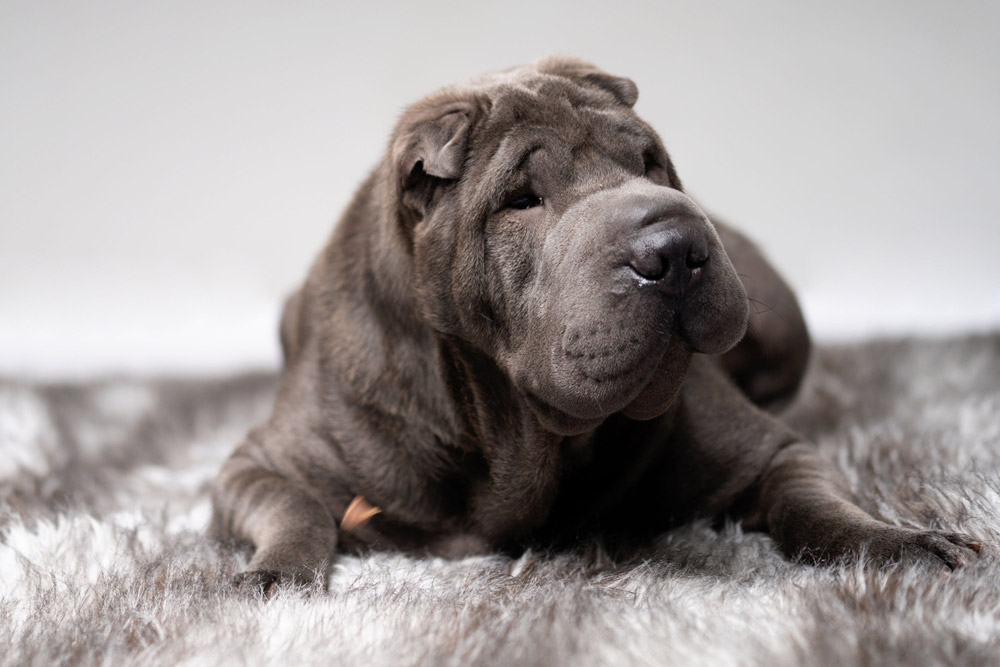Chinese Shar-Pei have a hippo-like face, small eyes, and an oversized coat, but these are just a few features that make this breed stand out. They’re loyal and highly intelligent, making them wonderful loving companions when socialized early. The wrinkles that line their faces may make them look like grumpy dogs, but the opposite is true.
Shar-Pei dogs have compact bodies that don’t need too much exercise and short coats that require occasional brushing. However, pet insurance is something you’ll have to consider when adopting one of these dogs because they are prone to certain health issues.
Shar-Pei dogs have a long and rather unstable history, but it’s just another factor that makes this breed so interesting. If we’ve piqued your interest, keep reading to discover 12 facts about the Chinese Shar-Pei.

The 12 Fascinating Chinese Shar-Pei Dog Facts
1. They Have Solid Blue-Black Tongues
Although the blue-black tongue is usually associated with the Chow Chow, Chinese Shar-Pei also have this feature. Some Shar-Pei tongues may have a slight color variation of lavender, which is a dilute color of the usual blue-black. It is unclear whether the Chow Chow and the Shar-Pei have this feature because they share distant ancestors, but both breeds did originate in China.
These blue-black tongues were seen as a bit of a superpower by some because they believed that they chased away evil spirits when the Shar-Pei barked.

2. It’s Always “Shar-Pei”
Whether you’re using “Shar-Pei” in a singular or plural form, it always remains “Shar-Pei.” Some people use “Shar-Peis” when referring to more than one dog, but this is incorrect because it is its own plural, just like moose, fish, and deer. Just like so many features about this dog, along with their unstable history, their name is also unique.
3. They Originated in China
Once again, Shar-Pei and the Chow Chow share something in common. They both originated from China and are some of the most ancient breeds of dogs in the world. In fact, the Shar-Pei is one of 14 of the oldest breeds recognized by the AKC.
These dogs are believed to have originated from the Southern part of China in a village called Tai Li, and evidence of their existence, seen in the form of statues, dates back to the Han Dynasty (206 BCE–220 CE). Although a large chunk of the Shar-Pei history has been lost, a translated 13th-century Chinese manuscript describes the characteristics of this breed. Although it’s a more recent find, this manuscript further points to the long existence of the Chinese Shar-Pei.

4. They’re Great Guard Dogs
The Shar-Pei was and has always been a great guard dog. In fact, it is what they were bred for—to guard livestock for the common people and guard the palace for the royal family. They were commonly bred for farmers and were known as the peasant’s dog, but they were also favored among the royals.
Although great guard dogs, they were also used for hunting boar, herding, and even dog fighting. Today, these wrinkly dogs make great companions and are happy to spend their days relaxing on the couch, but they often retain a natural guarding instinct and can be suspicious of unfamiliar people and dogs.
5. They Can Be Quite Anxious
It’s true that Shar Pei can be very anxious and fearful dogs, but this can be prevented by socializing them with people, children, and other pets from a young age. Reward based training will also help prevent unwanted nervous behaviors.
Anxiety can arise from fear, separation, and age. It can present itself in the form of aggression, house soiling, destructive behavior, excessive barking, pacing, and compulsive behaviors. Although Shar-Pei make wonderful companions they are generally not recommended for first-time dog owners. They also tend to prefer a quieter household and may not cope well with young children.

6. Familial Shar-Pei Fever Is Unique to This Breed
If you’ve never heard of Familial Shar-Pei Fever, you’re not alone. This inherited condition is only found in this breed and involves the dog having swollen hocks as well as episodic pain and fever. Sometimes, the muzzle is affected, too. Symptoms include fever, loss of appetite, dehydration, lethargy, joint and abdominal pain, heavy breathing, vomiting, diarrhea, obvious discomfort, and reluctance to move.
It’s important to take your Shar-Pei to the veterinarian if you see any of these signs. Treatment is usually supportive and includes anti-inflammatories and fluid therapy. Unfortunately dogs with recurrent episodes of Shar-Pei fever can also start to show signs of kidney disease.
7. They’re Great Apartment Dogs
If you live in an apartment, you need to do a lot of research into different dog breeds to determine which ones will suit your lifestyle best. Because Shar-Pei are usually laid-back and don’t require large amounts of exercise, they generally do well in apartments. However, it’s important to keep exercise and mental enrichment as part of your dog’s daily routine.
They’re also great apartment dogs because they don’t bark much unless they feel threatened. They’d rather assess a situation quietly than bark at every noise they hear. Because apartment buildings can be busy and loud, this is an important trait. Shar-Pei dogs have compact, medium-sized bodies that also make them more apartment-appropriate than larger breeds.

8. Shar-Pei Dogs Have Favorites
Shar-Pei puppies love any person who gives them a bit of attention, but as they grow up and are able to differentiate between their family members and strangers, they can become quite standoffish to people they don’t see regularly. They grow to feel comfortable with their family members but can see new people as a threat, which is why it’s important to socialize them from a young age.
Shar-Pei may also favor one family member over the other as they can form deep bonds. However, they do love all their family members and will get on well with them.
9. They Were Named After Their Coats
The name Shar-Pei translates to “sand skin” for a good reason. Their coat colors can vary significantly, with their breed standard colors including apricot, black, brown, blue, fawn, cream, chocolate dilute, and more. However, it’s the texture of their fur that is responsible for their name.
A Shar-Pei coat is short and rough and can be irritating to human skin—almost like sandpaper. Their prickly coats may not be as shiny and luscious as the coats of some other breeds, but they are low-maintenance, only requiring a brush through once a month to reduce shedding.

10. They Were Once the Rarest Breed on Earth
Not too long ago, the Shar-Pei were nearly extinct in China, their homeland. When China became a communist country, they decided that dogs were a luxury, and the owners were taxed heavily. Dog ownership became something only the rich could afford, and many dogs were slaughtered. This resulted in a drastic decrease in the Shar-Pei population, and they were named the rarest dog breed on earth by The Guinness Book of World Records during the 60s and 70s.
Thankfully, there were Shar-Pei breeders in Hong Kong and Taiwan who preserved the breed. In fact, it was a Hong Kong breeder who drew attention back to the breed and asked that the breed be saved. Life Magazine picked up on the story and published an issue on the Shar-Pei. This resulted in their popularity skyrocketing and ultimately saved the breed from extinction.
11. Their Wrinkles Provide Protection
Among the many purposes Shar-Pei had, dog fighting was one of them. These dogs weren’t the most ferocious or agile, but they did have one thing to their advantage—their wrinkles. Their wrinkles help protect their internal organs from injury if they get bitten by another dog, which can ultimately save their life.
These wrinkles also helped them in their guarding jobs when they had to protect the royal family from danger and the livestock from predators.

12. They Have Low Exercise Needs
Shar-Pei dogs don’t require vigorous exercise, and a daily walk will keep them happy. Although they’re laid-back, they certainly won’t pass up the opportunity to go on a hike, explore a park, or be a part of some other adventure. They’re not crazy about water and will usually do their best to avoid getting their paws wet. However, this isn’t true for all Shar-Pei, as some will venture out and go for a swim, especially if they were introduced to the activity from a young age.
Take Bethany Hamilton, a professional surfer, for example. Her Shar-Pei, Hana, sometimes joins Bethany on her surfboard for a fun time in the waves, and it looks like she has a pretty good time.

Conclusion
After reading these 12 facts about Chinese Shar-Pei, we’re sure you can agree that they’re a fascinating breed. A few fun facts about them are that they have blue-black tongues, they have low exercise needs, and whether used in the singular or plural form, it is always “Shar-Pei.”
From ancient times to the present day, these dogs make great pets and are loyal companions.
See also:
Featured Image Credit: Marcelino Pozo Ruiz, Shutterstock


















